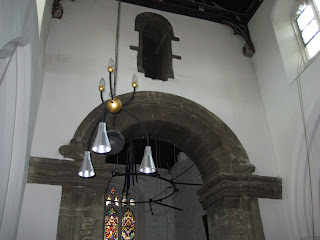After punting and lunch with Basie Gitlin (one of my former freshman counselors at Yale, who currently goes to Cambridge), I went on my first field trip with my Gothic Architecture class, to St. Bene'ts and St. Bodolph's. Both churches were extremely old (St. Bene'ts was dedicated in 1025, and contains a stone arch dating from the year 1000), and like all Gothic monuments, have undergone many, many modifications and restorations. St. Bene'ts contained no less than six different types of arches, indicating at least six renovations, and contained all kinds of odd asymmetrical features betraying its former history (e.g. a window leading straight into another wall, where the organ was added later on). St. Bodolph's was much more coherent and symmetrical, and had a much more decorated (and therefore more Catholic) chancel and high altar. One fascinating (and tragic) fact about all Gothic architecture is that none of it survives in its original state - during the Reformation the Protestants whitewashed over all the paintings (the whitewash is still in both churches today), broke all the stained glass, threw out the sculpture, and oriented all the pews toward the pulpit in the nave, rather than the high altar, changing the layout of the entire church. So all the stained glass, forward-oriented pews, ornate chancels, etc. in England are actually post-1850, when there was a movement to restore the old character of the churches. Amazing stuff! This is why I love architecture so much - each building tells an elaborate and provocative story of all the social, economic, political, and religious realities of its time. See below for pictures and Flickr link! http://www.flickr.com/photos/donnahorning/sets/72157627130881564/with/5908995102/
Punting boats on the Cam, with backs
Bridge of Sighs at St. John's College
Tower of St. John's College
Pembroke College garden
Stone archway (c. 1000) in St. Bene'ts
St. Bodolph's






No comments:
Post a Comment